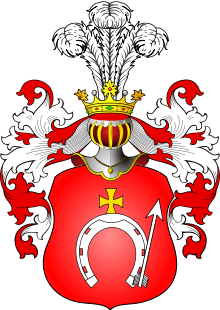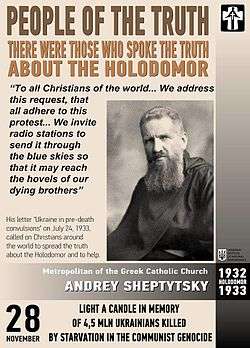Andrey Sheptytsky
Andrey Sheptytsky, (Ukrainian: Митрополит Андрей Шептицький; Polish: Andrzej Szeptycki; 29 July 1865 – 1 November 1944) was the Metropolitan Archbishop of the Ukrainian Greek Catholic Church from 1901 until his death in 1944.[2] His tenure spanned two world wars and seven political regimes: Austrian, Russian, Ukrainian, Polish, Soviet, General Government (Nazi), and again Soviet.
Venerable Metropolitan Andrey Sheptytsky, O.S.B.M. | |
|---|---|
| Metropolitan Galicia, Archbishop of Lviv (Lemberg) | |
.jpg) | |
| Church | Ukrainian Greek Catholic Church |
| Appointed | 12 December 1900 |
| Installed | 17 January 1901 |
| Term ended | 1 November 1944 |
| Predecessor | Metropolitan Archbishop Julian Sas-Kuilovsky |
| Successor | Cardinal Josyf Slipyj |
| Orders | |
| Ordination | 22 August 1892 |
| Consecration | 17 September 1899 by Metropolitan Archbishop Julian Sas-Kuilovsky |
| Personal details | |
| Birth name | Roman Aleksander Maria Sheptytsky |
| Born | 29 July 1865 Prylbychi, Kingdom of Galicia and Lodomeria, Austrian Empire |
| Died | November 1, 1944 (aged 79) Lviv, Ukrainian SSR |
| Buried | St. George's Cathedral, Lviv, Ukraine 49°50′19.48″N 24°0′46.19″E |
| Nationality | Ukrainian |
| Coat of arms |  |
| Sainthood | |
| Venerated in | Ukrainian Greek Catholic Church |
| Title as Saint | Venerable |
Andrey Sheptytsky, Pastoral letters, 2 August 1899.[1]
According to the church historian Jaroslav Pelikan, "Arguably, Metropolitan Andriy Sheptytsky was the most influential figure… in the entire history of the Ukrainian Church in the twentieth century".[3] The Lviv National Museum, founded by Sheptytsky in 1905, now bears his name.
Information-Resource Center of Ukrainian Catholic University that was opened on Septembre 2017 also bears his name - The Metropolitan Andrey Sheptytsky Center.[4]
Life
He was born as Count Roman Aleksander Maria Sheptytsky (Szeptycki) in a village 40 km west/northwest of Lviv called Prylbychi,[5] in the Kingdom of Galicia and Lodomeria, then a crownland of the Austrian Empire.
The Sheptytsky family is from an aristocratic Ruthenian line, which in the 19th century had become polonized, Roman Catholic and French-speaking, while Fredro family is also of noble Polish origin. Among his ancestors, there were many important church figures, including two metropolitans of Kyiv, Atanasy and Lev. His maternal grandfather was the Polish writer Aleksander Fredro. One of his brothers, Klymentiy Sheptytsky, M.S.U., became a Studite monk, and another, Stanisław Szeptycki, became a military general in the Polish Army. He was 2 m 10 cm (6 ft. 10 in.) tall.
Sheptytsky received his education first at home and then in Kraków. After graduating he went to serve in the Austro-Hungarian army but after a few months fell sick and was forced to abandon it. Instead, he studied law in Kraków and Wrocław, receiving his doctorate in 1888. During his studies he visited Italy, where he was granted an audience with Pope Leo XIII at the Vatican, and to the Ukrainian heartland of Kyiv, then under Russian rule, where he met some of the most prominent Ukrainian personalities of that time. He also visited Moscow.
Religious life
Despite his father's opposition, Sheptytsky became a monk at the Basilian monastery in Dobromyl, returning to his roots to serve what was regarded as the peasant Ukrainian Greek Catholic Church. He took the name, Andrew, after the younger brother of Saint Peter, Andrew the Apostle, considered the founder of the Byzantine Church and also specifically of the Ukrainian Church. He then studied at the Jesuit Seminary in Kraków, receiving a doctoral degree in theology in 1894. In 1892 he was ordained a priest in Przemyśl. He was made rector of the Monastery of St Onuphrius in Lviv in 1896.

In 1899, following the death of Cardinal Sylvester Sembratovych, Sheptytsky was nominated by Emperor Franz Joseph to fill the vacant position of Ukrainian Greek Catholic Bishop of Stanyslaviv[6] (now Ivano-Frankivsk), and Pope Leo XIII concurred. Thus he was consecrated as bishop in Lviv on 17 September 1899 by Metropolitan Julian Sas-Kuilovsky assisted by Bishop Chekhovych and Bishop Weber, the Latin-Rite auxiliary of Lviv.[7] A year later, on 12 December 1900 and following the death of Sembratovych's successor, Sheptytsky was appointed, at the age of thirty-six, Metropolitan Archbishop of Lviv and enthroned on 17 January 1901.[8]
Sheptytsky visited North America in 1910 where he met with Ukrainian Greek Catholic immigrant communities in the United States; attended the twenty-first International Eucharistic Congress in Montreal; toured Ukrainian communities in Canada; and invited the Redemptorist fathers ministering in the Byzantine rite to come to Ukraine.
After the outbreak of World War I, Sheptytsky was arrested by the Imperial Russian government and imprisoned in monastery of Saint Euthymius, Suzdal.[9] He was released in March 1918 and returned to Lviv from the Russian Empire. Bolsheviks destroyed his parents' rural house in Prylbychi where he was born.[9] During the destruction there were lost family archives.[9]

As a student, Sheptytsky learned Hebrew in order to better relate to the Jewish community. During pastoral visits to Jewish villages, he was sometimes met with the Torah. During World War II he harbored hundreds of Jews in his residence and in Greek Catholic monasteries.[10] He also issued the pastoral letter, "Thou Shalt Not Kill,"[11] to protest Nazi atrocities. Alone among the church leaders in Nazi-occupied Europe, Sheptytsky openly spoke in defense of the persecuted Jews. He sent an official letter, as the First Bishop of the Ukrainian Catholic Church, to Hitler and Himmler protesting about the destruction of the Jews. In a special Pastoral Letter addressed to his Ukrainian faithful, he strongly forbade them (under the pain of excommunication) from participating or helping in the destruction of Jews. In addition, he issued secret instructions to his secular and monastic clergy, ordering them to help the Jews by hiding them on church property, feeding them and smuggling them out of the country. One of the rabbis whose life was saved by Metropolitan Sheptytsky, David Kahane, stated: "Andrew Sheptytsky deserves the undying gratitude of the Jews and the honorific title 'Prince of the Righteous'".[12] During this period he secretly consecrated Josyf Slipyj as his successor.
Sheptytsky in the early years of his episcopacy expressed strong support for a celibate Eastern Catholic clergy. Yet he said to have changed his mind after years in Imperial Russian prisons where he encountered the faithfulness of married Russian and Ukrainian Orthodox priests and their wives and families. After this, he fought the Roman Catholic leaders on their attempts to force celibacy on the Eastern Catholic Priests.[13]
Sheptytsky was also a patron of artists, students, including many Orthodox Christians, and a pioneer of ecumenism — he also opposed the Second Polish Republic policy of forced conversion of Polish Ukrainians into Latin Rite Catholics.[14] He strove for reconciliation between ethnic groups and wrote frequently on social issues and spirituality. He also founded the Studite and Ukrainian Redemptorist orders, a hospital, the National Museum, and the Theological Academy. He actively supported various Ukrainian organizations such as the Prosvita and in particular, the Plast Ukrainian Scouting Organization, and donated a campsite in the Carpathian Mountains called Sokil, and became the patron saint of the Plast fraternity Orden Khrestonostsiv.
Sheptytsky died in 1944 and is buried in St. George's Cathedral in Lviv. In 1958 the cause for his canonization was begun; but stalled at the behest of Cardinal Stefan Wyszynski. Pope Francis approved his life of heroic virtue on 16 July 2015, thus proclaiming him to be Venerable.[5]
Jews who were saved thanks to actions of Andrey Sheptytsky have lobbied Yad Vashem for years to have him named Righteous Among the Nations, just as his brother Klymentiy Sheptytsky had been, but so far Yad Vashem has failed to act, mostly due to concerns with his initial belief that German invaders would be better for Ukraine than the atrocious Soviet Union had been.[15]
Memory
The first monument to Metropolitan Andrei Sheptytsky was erected during his lifetime in 1932. Destroyed in 1939.
July 29, 2015 the opening day in Lviv of the monument to Metropolitan Andrei Sheptytsky, to the 150th anniversary of his birth.[16]
Images
.jpg) Father Andrey in Rome, 1921
Father Andrey in Rome, 1921

 Archbishop Andreas Szeptycki in Philadelphia October 1910.
Archbishop Andreas Szeptycki in Philadelphia October 1910.
Notes
- Hakh, I. Great descendant of the old family (Великий нащадок давнього роду). Zbruč. 31 July 2015
- "Митрополит Андрей Шептицький - Україна Incognita". incognita.day.kyiv.ua. Retrieved 2020-04-09.
- Pelikan, Jaroslav (1990). Confessor Between East and West. Grand Rapids: William B. Eerdmans Publishing Company. ISBN 0-8028-3672-0.
- "About the Center". UKU Center (in Ukrainian). 2018-05-11. Retrieved 2019-08-30.
- "150 anniversary of the birth of Metropolitan Andrey Sheptytsky". 112.international. Retrieved 2020-04-09.
- Kitsoft. "Єгипет - July 29 – 150 anniversary of the birth of Andrey Sheptytsky, Metropolitan of Ukrainian Greek Catholic Church". egypt.mfa.gov.ua. Retrieved 2020-04-09.
- Athanasius D. McVay (10 April 2008). "The Reluctant-to-Accept and the Reluctantly-Accepted Bishop". Annales Ecclesiae Ucrainae. Retrieved 28 March 2011.
- "Archbishop Andrij Aleksander Szeptycki (Sheptytsky), O.S.B.M." Catholic-Hierarchy.org. David M. Cheney. Retrieved 23 January 2015.
- Senkivska, N. Metropolitan Andrei: life story in retro-photographs (Митрополит Андрей: життєпис у ретро-світлинах.). Zbruc. 1 November 2016
- Holocaust Survivor Speaks at UCU, Praises Sheptytskys, Ukrainian Catholic University News
- "Не убий!". Retrieved 22 December 2015.
- Petro Mirchuk: THE MATTER OF THE METROPOLITAN OF THE UKRAINIAN CATHOLIC CHURCH, ANDRIJ SHEPTYTSKY
- "American Carpatho-Russian Orthodox Diocese of the USA – Mandated Celibacy Among US Eastern Catholic Priests Theme of Seminar in Rome". Retrieved 22 December 2015.
- Cuius Regio, TIME Magazine, 24 October 1938
- THE JEWISH WEEK: Righteous Gentile Or Nazi Supporter? Wartime leader of Ukrainian church sheltered many Jews, but the decades-long campaign has not brought Yad Vashem’s highest honor. 04/09/12 By Steve Lipman
- "Metropolitan Andriy Sheptytsky monument unveiled in Lviv". EMPR: Russia - Ukraine war news, latest Ukraine updates. 2015-07-30. Retrieved 2020-08-12.
Further reading
- Cyril Korolevsky, Metropolitan Andrew (1865–1944), Translated and Revised by Serge Keleher, Stauropegion, 1993, Lviv.
- Aharon Weiss, Andrei Sheptytsky in Encyclopedia of the Holocaust vol. 4, pp. 1347–8
Films
- Yad Vashem Interviews a Jew Whom Sheptytsky Rescued During the Holocaust on YouTube
- Recording of a Sermon by Metropolitan Sheptytsky on YouTube
- Saved by Sheptytsky – a documentary about some of 150 Holocaust survivors saved by Sheptytsky as kids on YouTube
External links
| Wikimedia Commons has media related to Andrey Sheptytsky. |
- (in English) Andrei Sheptytsky at the Encyclopedia of Ukraine
- Metropolitan Andrey Sheptytsky Institute of Eastern Christian Studies
- Metropolitan Andrei Sheptytskyi who was called the "apostle of Ukrainian truth", "Welcome to Ukraine" Magazine
- Thou Shalt Not Kill (Ukrainian, pdf of scanned images)
- Thou Shalt Not Kill (English, pdf)
- He Welcomed the Nazis and Saved Jews
- Metropolitan Sheptytsky, Apostle of Church Unity
- Sheptytsky Award Tablet Magazine, Vladislav Davidzon
| Religious titles | ||
|---|---|---|
| Preceded by Julian Sas-Kuilovsky |
Metropolitans of Galicia and Archbishop of Lemberg (as locum tenens in 1900) 1901-1944 |
Succeeded by Josyf Slipyj as Locum tenens until 1963 |
| Bishop of Stanislau 1899—1900 |
Succeeded by Hryhoriy Khomyshyn | |